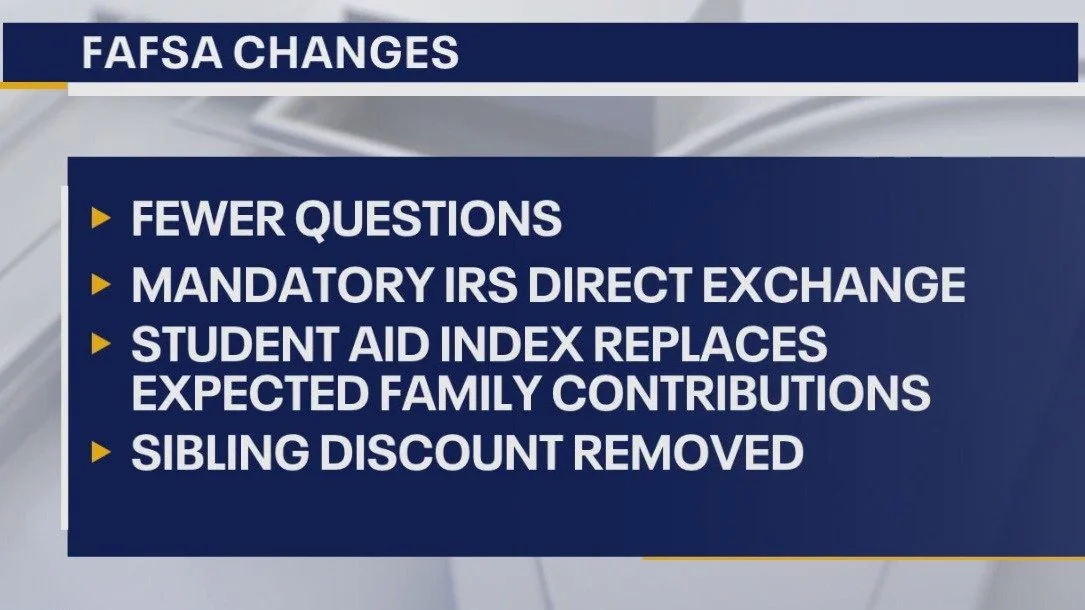Navigating the 24/25 FAFSA changes: What Students and Families Need to Know
We are diving into the recent changes to the Free Application for Federal Student Aid (FAFSA) and how they impact students and families seeking financial aid for the 2024-25 academic year. The FAFSA process has undergone significant updates aimed at simplifying the application and expanding access to financial aid. Here's what you need to know.
A screen grab showing a few changes that are coming to the new FAFSA process. Credit: FOX26 HOUSTON
Key Changes to the FAFSA Process
Simplified Form The new FAFSA form has been streamlined from 108 questions down to 36. This major reduction in questions is designed to make the application process more straightforward and less time-consuming for students and families. The simplified form now closely aligns with federal income tax returns, reducing redundancy and confusion.
Delayed Release Date Traditionally, the FAFSA form becomes available on October 1 each year. However, for the 2024-25 academic year, the form will be released by December 31, 2023. This delay is to ensure the successful implementation of the new changes and to provide a smoother application experience.
Expanded Pell Grant Eligibility More low-income students will qualify for Pell Grants under the new rules. The Department of Education estimates that approximately 610,000 additional students will receive Pell Grants, with nearly 1.5 million more students eligible for the maximum Pell Grant. Eligibility now factors in family size and federal poverty levels, broadening the scope for assistance.
Changes to Income Reporting Certain types of untaxed income, such as cash support and veterans’ education benefits, will no longer need to be reported on the FAFSA. Additionally, child support received will be considered an asset rather than untaxed income, potentially leading to more favorable financial aid assessments for some students.
Negative Student Aid Index For the first time, the student aid index (SAI) can be negative, going as low as -$1,500. This change aims to better represent the financial need of the most economically disadvantaged students, allowing for a more accurate calculation of aid.
New User Requirements Every contributor to the FAFSA, including students, spouses, and parents, must now have a StudentAid.gov account. This new requirement ensures a more secure and accurate submission process, leveraging technology to reduce errors and enhance data protection.
What These Changes Mean for You
The FAFSA changes aim to make financial aid more accessible and the application process less burdensome. For students from low-income backgrounds, the expansion of Pell Grant eligibility is particularly significant. Additionally, the simplified form and new income reporting rules should make the application process quicker and easier to navigate.
Tips for Navigating the New FAFSA
Create Your StudentAid.gov Account Early Ensure that you, and your parents if you’re a dependent student, create a StudentAid.gov account well in advance. This will streamline the application process once the form becomes available.
Gather Necessary Documents Despite the reduced number of questions, you’ll still need documents like your Social Security number, federal income tax returns, W-2s, and records of untaxed income. Gather these documents ahead of time to make the process smoother.
Stay Updated Keep an eye on announcements from the Department of Education and your school’s financial aid office. They will provide the latest information and any additional steps you may need to take.
Utilize Resources There are numerous resources available to help you navigate the new FAFSA. Websites like StudentAid.gov offer detailed guides, and many high schools and colleges provide FAFSA workshops and counseling services.
Conclusion
The FAFSA updates for the 2024-25 academic year represent a significant shift towards making financial aid more accessible and the application process more user-friendly. By understanding these changes and preparing accordingly, students and families can take full advantage of the financial aid opportunities available to them. Stay informed, be proactive, and don’t hesitate to seek help if you need it. The Tukole Foundation is here to support you every step of the way.
For more information and resources, visit StudentAid.gov and sign up for our newsletters giving updates and tips on higher education.


